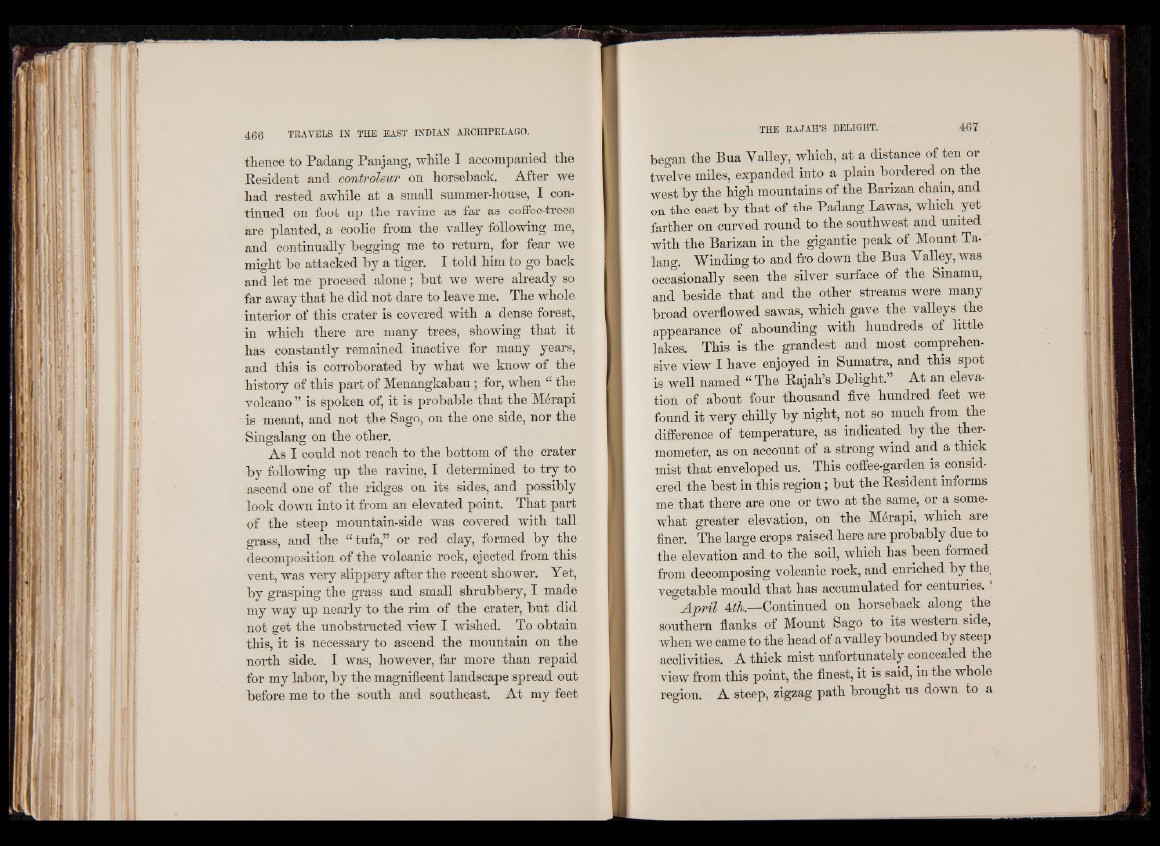
thence to Padang Panjang, while I accompanied the
Resident and contrôleur on horseback. After we
had rested awhile at a small summer-house, I continued
on foot up the ravine as far as coffee-trees
are planted, a coolie from the valley following me,
and continually begging me to return, for fear we
might be attacked by a tiger. I told him to go back
and let me proceed alone ; but we were already so
far away that he did not dare to leave me. The whole
interior of this crater is covered with a dense forest,
in which there are many trees, showing that it
has constantly remained inactive for many years,
and this is corroborated by what we know of the
history of this part of Menangkabau ; for, when “ the
volcano ” is spoken of, it is probable that the Mérapi
is meant, and not the Sago, on the one side, nor the
Singalang on the other.
As I could not reach to the bottom of the crater
by following up the ravine, I determined to try to
ascend one of the ridges on its sides, and possibly
look down into it from an elevated point. That part
of the steep mountain-side was covered with tall
grass, and the “ tufa,” or red clay, formed by the
decomposition of the volcanic rock, ejected from this
vent, was very slippery after the recent shower. Yet,
by grasping the grass and small shrubbery, I made
my way up nearly to the rim of the crater, but did
not get the unobstructed view I wished. To obtain
this, it is necessary to ascend the mountain on the
north side. I was, however, far more than repaid
for my labor, by the magnificent landscape spread out
before me to the south and southeast. At my feet
began the Bua Valley, which, at a distance of ten or
twelve miles, expanded into a plain bordered on the
west by the high mountains of the Barizan chain, and
on the east by that of the Padang Lawas, which je t
farther on curved round to the southwest and united
with the Barizan in the gigantic peak of Mount Ta-
lang. Winding to and fro down the Bua Valley, was
occasionally seen the silver surface of the Sinamu,
and beside that and the other streams were many
broad overflowed sawas, which gave the valleys the
appearance of abounding with hundreds of little
lakes. This is the grandest and most comprehensive
view I have enjoyed in Sumatra, and this spot
is well named “ The Rajah’s Delight.” At an elevation
of about four thousand five hundred feet we
found it very chilly by night, not so much from the
difference of temperature, as indicated by the thermometer,
as on account of a strong wind and a thick
mist that enveloped us. This coffee-garden is considered
the best in this region; but the Resident informs
me that there are one or two at the same, or a somewhat
greater elevation, on the Merapi, which are
finer. The large crops raised here are probably due to
the elevation and to the soil, which has been formed
from decomposing volcanic rock, and enriched by the
vegetable mould that has accumulated for centuries. |
A p ril Ath.—Continued on horseback along the
southern flanks of Mount Sago to its western side,
when we came to the head of a valley bounded by steep
acclivities. A thick mist unfortunately concealed the
view from this point, the finest, it is said, in the whole
region. A steep, zigzag path brought us down to a